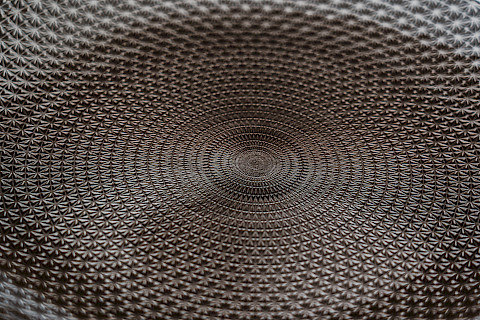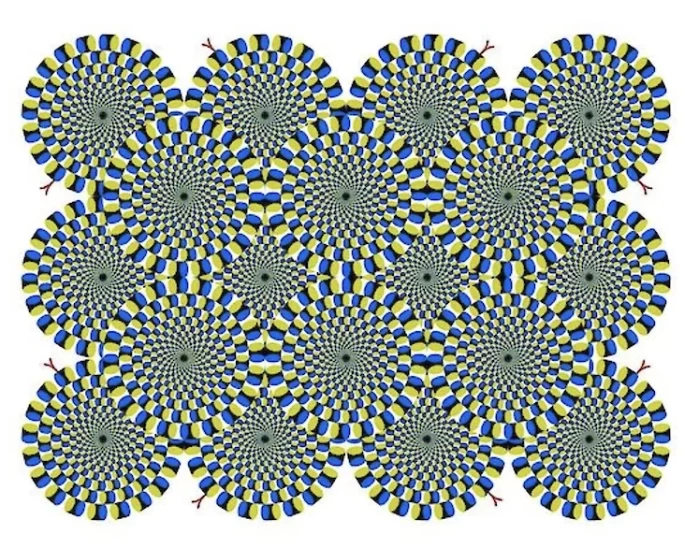

Optical illusions and perception
"Our senses can be trusted but they can be easily fooled"
- Aristotle
Way back in 350 BC, philosophy great Aristotle noticed that when watching a waterfall and then shifting your gaze over to static rocks, the rocks will begin to appear to move in the opposite direction. It is what is now called the motion aftereffect or the waterfall illusion. He felt that the brain's neurons could not keep up with the change of motion so when our gaze is shifted from the moving water to the still rocks, our neurons over-compensate which causes us to perceive the rocks as moving. Even earlier than that, still in Ancient Greece, people became fascinated with Greek temple rooftops and the illusion that they appeared to be curved when viewed from below when they were in fact slanted. Greek philosopher Epicharmus tried to explain that our brains were not at fault and that we were perceiving the image correctly, it was our senses that were actually deceiving us. Protagoras said our eyes had nothing to do with how we saw things and that the illusions were dependent on the environment in which they were viewed. All of these are descriptions and theories of what we now refer to as optical illusions.
In the world of paranormal investigation, we are often looking for things in low light, staring at grainy photos or just staring at surfaces for long periods of time. It means we are prone to experiencing all sorts of optical illusions and potentially labelling them as something paranormal.
I have a whole bunch of articles dedicated to different illusions and how they can tie in with paranormal investigating. These are just a few:
The autokinetic effect
Also known as autokinesis, this phenomenon occurs when a small stationary source of light that is surrounded by a dark environment appears to be moving. It actually isn't moving, but there are scenarios where we believe it is moving. It is thought that because it is surrounded by darkness, there is no reference point for our brains to use. The jury is out as to whether it is more a fault of the eye or the brain. While some believe it has to do with how the brain perceives the information, others believe it is more to do with involuntary eye movements.

Afterimage
Light is something that has a huge effect on the way we experience things on a paranormal investigation. Often we are investigating with the lights off and using flashlights or lanterns. The problem here is that the rods in our eyes are sensitive to light. They don't interpret colour, only light. If our eyes are exposed to bright light, the cones and rods become overexposed, and often we will see a large flash of light, much like you see in an overexposed photograph. This can also cause a person to see what is called an afterimage.
When you stare at a black image for a prolonged period of time and then look at a white piece of paper, you can see the image floating down. It just shows us what happens when our eyes are trying to adjust. It can make us see things that are not there. Try it! Stare at the white dot on the left image for 30 seconds. Now move your line of sight to the black dot on the right. You will see a 'lady in white' slowly float down.

Image Source: Stuff Paranormal Investigators Need To Know Volume 1 by Sarah Chumacero (2019)
Peripheral Drift Vision
Commonly, people will often report a sighting of a shadow person lurking in the shadows of a dark corner or a doorway. One explanation could be what is called peripheral drift vision. Look at the following image. While it looks like the wheels are moving they really aren't. It is an optical illusion caused by the smart placement of black white and grey lines which are designed to create this illusion.

Image Source: Akiyoshi Kitaoka (Kitaoka and Ashida 2003)
There is very much a common theme with these optical illusions and the paranormal. A lot of them occur in the dark or when there are significant or fast changes in light. There is no hard and fast rule that says you must investigate the paranormal in the dark. Of course, it makes it spooky but you can still do what you need to do with the lights on. Some people do like to have the lights off as a form of sensory deprivation as they feel it helps them on a psychic level. Everyone does things differently, however, we need to at least be aware of the things that can make us see things that are not really there. These are very small examples of a long list of things that can cause us to misinterpret things when it comes to the paranormal. It is not saying that what you have experienced is not paranormal, however, it is a possible explanation that should always be considered. Studies actually indicate that just having an understanding and applying critical thinking can help us decipher if what we are seeing is the truth or if it is our perception of it. Humans are a key part of this puzzle. Suggestions and technology can sway us in the direction of the paranormal, particularly if you are attending a public paranormal investigation or watching your favourite paranormal show. Illusion mixed with suggestion is sometimes all we need to be convinced, and this is where much discussion and critical thinking must be applied.
From prehistoric times, humans have evolved as pattern seeking and storytelling species. While the capacity to find patterns and infer meanings had obvious advantages for survival, the brain is not always successful in distinguishing meaningful and meaningless patterns. In fact, "pattern finding" and "order seeking" mechanisms form the basis for nearly all existing myths, superstitions, cultural taboos and ritual practices all over the world. The same mechanism also makes us extremely vulnerable to all kinds of deceptions and manipulative techniques that impair our critical faculties. We may imagine things that don’t exist, make false judgments, accept uncritical claims, misinterpret facts and arrive at conclusions that are completely at odds with reality. The scientific age is riddled with intriguing contradictions and man-made follies. The technology-driven consumer culture and entertainment industry has fueled the growth of primitive superstitions, myths and new age beliefs. The need to promote a rational discussion on science, technology and equitable social development has never been so pressing. The first thing to guard against such trends is to be aware of the subtle persuasive techniques, marketing strategies and advertisement gimmicks that make us increasingly helpless consumers in the scientific age. Conveying the excitement of science and scientific discovery is no doubt an essential part of science education and public outreach activities. But equally important is to learn to draw the distinction between unsubstantiated claims and factual findings based on sound reasoning and evidence. Discerning magical thinking and vague ideas from the realm of possibilities that lie within limits of physical laws is therefore important to inculcate scientific temper.
Banyal, Ravinder. (2012). Parallel Sessions: Scientific Superstitions and Scientific Temper Myths, Superstitions and Propaganda in Scientific Age.
Perception VS Reality
Perception is how our brain translates the things that we see and feel. It is subject to our own interpretation of a situation. People often confuse perception with that of reality. Reality is things as they really are. Our belief systems, our education, our past experiences and just who we are as a person shape how we perceive things. When it comes to the paranormal field, beliefs have a massive influence on how we perceive a situation. For example, if someone doesn't believe in ghosts and something sees something out of the corner of their eye, they are more likely to blame it on some sort of natural phenomenon or simply a trick of the eye. Someone however who is very much into the spirit world may have the exact same experience, and their perception is that it is something paranormal. So who is right?
How reality appears to us depends on what kind of glasses we view the world in. The exact same thing can happen to 2 people in a room, yet they can both walk away with a completely different perception of what has happened. To them, their perception of the situation is their reality and in their mind, they are both right. The challenge in any situation is to separate perception from reality. While you may ask a 3rd party to decide this, again you are potentially being influenced by their own perception of what has happened. When everyone thinks so differently, how the hell are we supposed to know what the actual reality is? What really happened?
Perception is not reality. If you are in a room on an investigation looking to find paranormal phenomena and a door slams, your first reaction is likely that it is something paranormal. If on the other hand, you are on an investigation to disprove the paranormal from a skeptical point of view, your first reaction is that it was just the wind or a weighted door. It was something of a natural cause. After applying some critical thinking, that first initial reaction is the one that you have no control over. That is the one that is influenced by your belief system and the whole reason you are there in the first place.
This is probably one of the biggest reasons why as a society we are never going to unanimously agree on what is paranormal and what isn't or even if there is something paranormal to begin with. There is so much more at play. Belief, perception, reality and everything in between. Perhaps Aldous Huxley summed it up best:
"There are things known and things unknown, and in between are the doors of perception."
Aldous Huxley
References
https://www.bbc.com/future/bespoke/story/20150130-how-your-eyes-trick-your-mind/index.html
http://theliterarylink.com/illusions.html
https://www.vox.com/science-and-health/20978285/optical-illusion-science-humility-reality-polarization
Banyal, Ravinder. (2012). Parallel Sessions: Scientific Superstitions and Scientific Temper Myths, Superstitions and Propaganda in Scientific Age.
https://htschool.hindustantimes.com/editorsdesk/knowledge-vine/optical-illusions-tracing-their-origin-and-evolution
Cover Photo by Castorly Stock : https://www.pexels.com/photo/a-photo-of-metal-abstract-3693257/
If you enjoy LLIFS, consider buying me a book (otherwise known as buy me a coffee but I don't drink coffee and I LOVE books). Your donation helps to fund the LLIFS website so everyone can continue to access great paranormal content and resources for FREE!

Top pages with similar subjects
Don't forget to follow the Facebook page for regular updates
Join the mailing list to receive weekly updates of NEW articles. Never miss an article again!
Buy the latest and past issues Haunted Magazine
Check out the books written by LLIFS